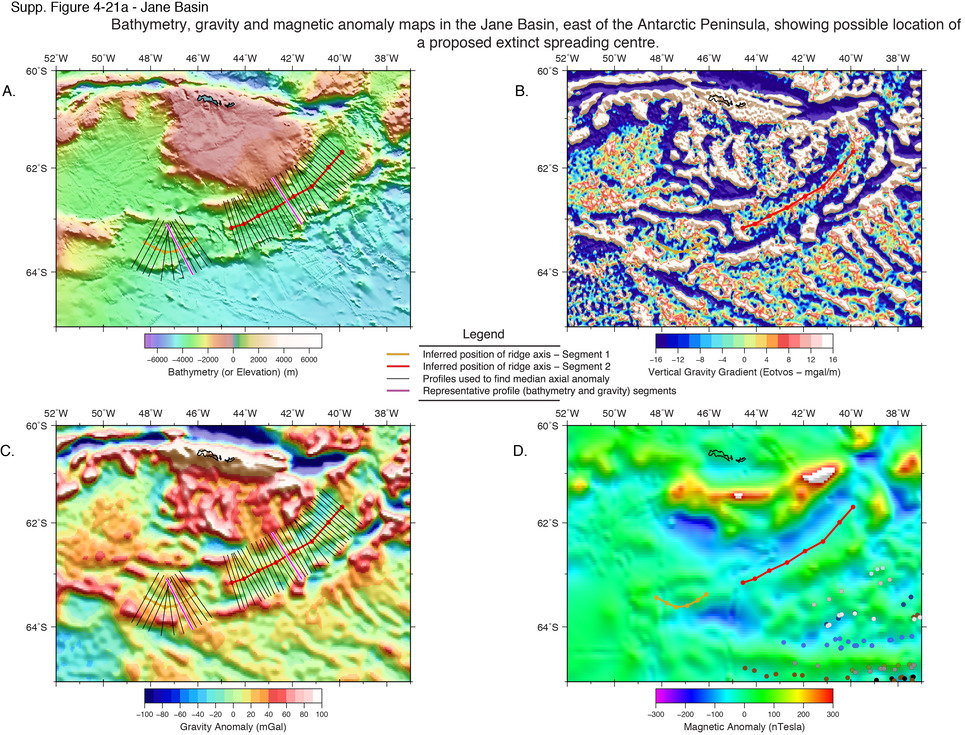| Ocean: | Marginal basin |
| Spreading center type: | Back-arc basin spreading center |
| Time of cessation: | Suggested ages: ca. 20 Ma (Barker et al., 1984), 14.4 Ma (Bohoyo et al., 2002) or ca. 15 Ma, C5ADn (Maldonado et al., 1998), 19 Ma or 25 Ma (Eagles and Jokat, 2014) |
| Subsequent active spreading center: | (?) East Scotia Sea BAB spreading center |
| Cessation style: | Not constrained by available data |
| Later deformation or volcanism: | Cessation of subduction of Weddell Sea crust, and the subsequent collision of oceanic crust formed in the Jane Basin with the Jane Arc may have led to compressional deformation within this basin. |
Grikurov and Leychenkov (2012) regional geological map of the Antarctic margin indicates an approximately 500 km long extinct spreading ridge to the south of the South Orkney microcontinent and to the north of the Jane Bank, an extinct island arc. This proposed backarc basin spreading center is thought to be of Neogene age and likely follows the placement given by Maldonado et al. (1998). An early study by Barker et al. (1984) proposed a ridge-crest collision between the Jane Bank and the Southern Scotia Ridge at around 20 Ma. This presents one possible age and mechanism for the cessation of spreading in this basin. Alternatively, Maldonado et al. (1998) infer that the Jane Basin may have ceased spreading during the middle Miocene, after around 15 Ma.
Bohoyo et al. (2002) interpreted magnetic anomalies within the basin to be the sequence C5Dn (17.6 Ma) to C5ADn, giving an extinction time of 14.4 Ma. Bohoyo et al. (2002) argue that spreading was initially concurrent with crustal spreading in the Weddell Sea, whilst this crust was being subsequently consumed at the Jane Bank subduction zone. They argue that the Weddell Sea ridge then collided with the Jane Arc and that this led to the initiation of the back-arc spreading within the Jane Basin (ibid).
Eagles and Jokat (2014) favoured an age estimation for the Jane Basin that is based upon thermal subsidence models, because they believe that these may be more reliable than interpretation of the low-magnitude magnetic anomalies found within the basin. Their method, however, offers two significantly different possible ages of basin formation, which are from between 27 to 19 Ma or between 32 to 25 Ma (Eagles and Jokat, 2014).
Barker et al. (1984) suggest that collision of the Jane Bank, an island arc, with the South Scotia Ridge at ca. 20 Ma, could have coincided with or post-dated cessation of spreading within the back-arc basin, if an earlier time of formation is accepted for the Jane Basin crust.
The Jane Basin is sandwiched between a microcontinent and an inactive volcanic arc that is thought to have collided with the South Scotia Sea transform ridge, making interpretation of the location of extinct ridge axial segments difficult. As with several other back-arc spreading centers, it is difficult to see a strong gravity signal from the axis (see for example the extinct Grenada Basin or the active North Fiji Basin).
Barker, P.F., Barber, P. and King, E.C., 1984, An early Miocene crest-trench collision on the South Scotia Ridge near 36 W, Tectonophysics, v. 102, p. 315–332.
Bohoyo, F., Galindo-Zaldívar, J., Maldonado, A., Schreider, A.A. and Suriñach, E., 2002, Basin development subsequent to ridge-trench collision: the Jane Basin, Antarctica, Marine Geophysical Researches, v. 23, no. 5, p. 413–421.
Eagles, G. and Jokat, 2014, Tectonic reconstructions for paleobathymetry in Drake Passage, Tectonophysics, v. 611, p. 28-50.
Grikurov, G. E. and Leychenkov, G. 2012. Tectonic map of Antarctica, Scale 1: 10 000 000, First edition, Commision for the Geological Map of the World.
Maldonado, A., Zitellini, N. and Leitchenkov, G., 1998, Small ocean basin development along the Scotia–Antarctica plate boundary and in the northern Weddell Sea, Tectonophysics, v. 296, p. 371–402.


